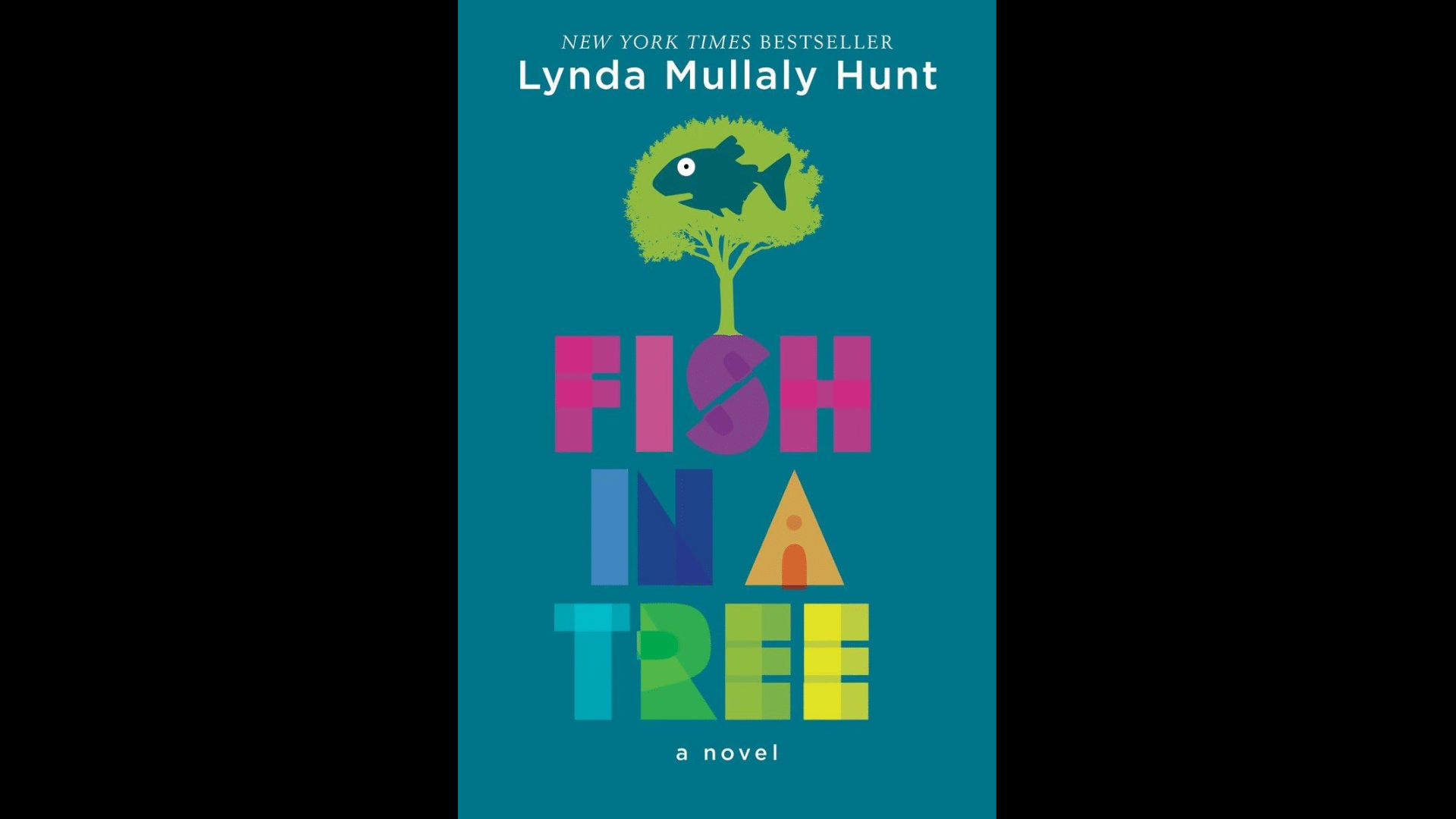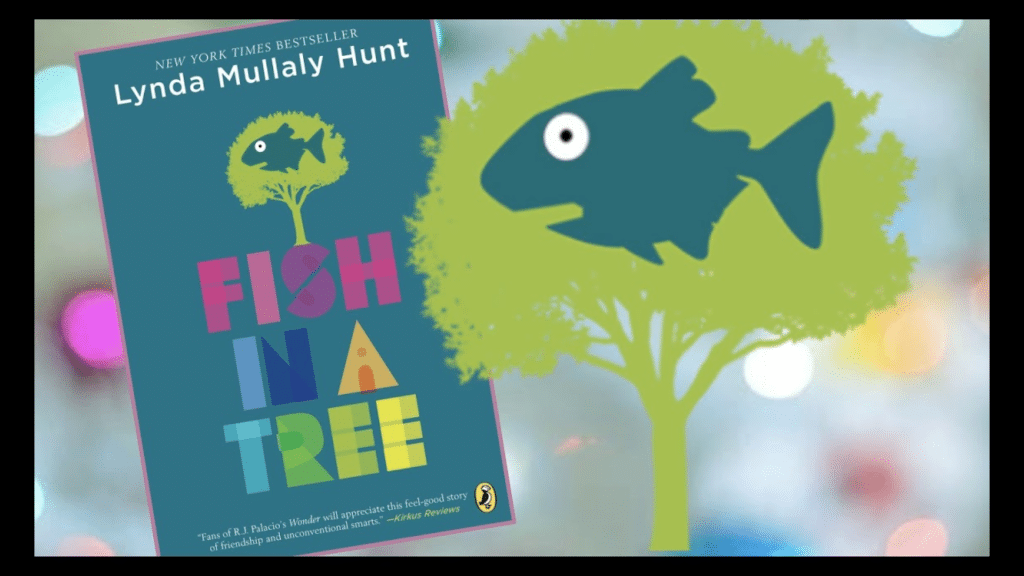Fish in a Tree by Lynda Mullaly Hunt is a middle-grade novel first published in 2015. It tells the story of Ally Nickerson, a sixth-grader with dyslexia who hides her struggles by acting out in class.
Her world changes when a new teacher, Mr. Daniels, sees her potential and helps her realize that she simply learns in a different way. Alongside her new friends, Keisha and Albert, Ally begins to find courage, acceptance, and hope.
In this blog, I’ll share everything you need to know about the book, including a quick summary, a full plot guide, chapter highlights, main characters, themes, symbols, the author’s purpose, and even where to buy it.
This book matters because it celebrates differences and values every learner.
Overview of Fish in a Tree
- Author: Lynda Mullaly Hunt.
- Published: Released in 2015 by Nancy Paulsen Books.
- Genre: Middle-grade realistic fiction.
- Pages: About 288 pages in most editions.
The book follows Ally Nickerson, a sixth-grader with dyslexia, as she learns to embrace her differences with the help of a supportive teacher and loyal friends.
It has become a classroom favorite for its honest portrayal of learning struggles and its uplifting message. At its heart, Fish in a Tree shows that every child has unique gifts and deserves to be valued for who they are.
Plot Summary

Fish in a Tree is a heartwarming story about Ally Nickerson, a bright girl with dyslexia who hides her struggles behind jokes and mischief. With the help of a caring teacher and true friends, she learns that being different is also a kind of strength.
Beginning
The story opens with Ally Nickerson, a sixth-grader who struggles with dyslexia. To cover up her difficulties with reading and writing, she often misbehaves or plays things off as jokes.
In the early chapters, Ally embarrasses herself by giving her teacher a sympathy card at a baby shower and accidentally writing on a desk instead of paper.
She feels isolated and misunderstood, especially since her dad’s military career forces her to switch schools often. Drawing in her sketchbook becomes her safe escape, and she remembers her grandfather’s support as one of the few moments where she felt encouraged.
Middle
Things begin to change when Ally meets Mr. Daniels, her new teacher. Unlike others, he notices her struggles are not laziness but a different way of learning. He gives her strategies, builds her confidence, and introduces her to chess, where she shines.
At the same time, Ally forms friendships with Keisha and Albert, who also feel like outsiders. Together they defend one another, celebrate small wins, and grow stronger as a group.
These bonds help Ally start to see herself differently, standing up to bullies like Shay and realizing she has strengths beyond traditional academics.
Ending
As the story moves toward its close, Ally begins to embrace her identity. With Mr. Daniels’ encouragement, she accepts that dyslexia is only part of who she is and that it does not define her intelligence.
Her friendships deepen as Keisha and Albert continue to stand by her, and she learns that true support can make all the difference.
The title metaphor – “everybody is smart in different ways” – resonates with Ally as she stops apologizing for being herself. The book ends on a hopeful note, showing Ally more confident, supported, and ready to move forward with the knowledge that her uniqueness is a strength.
Main Characters of Fish in a Tree
The novel brings together a range of characters who shape Ally’s journey and highlight the book’s themes of acceptance, friendship, and growth.
- Ally Nickerson – A sixth-grader with dyslexia. She covers up her struggles with misbehavior but gradually learns to accept herself. Her journey highlights resilience and the value of support.
- Mr. Daniels – Ally’s caring new teacher. He understands her challenges and teaches in ways that build her confidence, becoming both a mentor and guide.
- Keisha – A bold and loyal friend who stands up for Ally against bullies, showing the strength of true friendship.
- Albert – A quiet, intelligent boy who feels like an outsider. His courage and kindness inspire Ally.
- Shay & Travis – Shay is the class bully, while Travis, Ally’s older brother, encourages her and shares his own struggles.
- Shay – Represents cruelty and judgment through her constant bullying of Ally and others.
- Jessica – Shay’s follower, who later realizes Shay is not a true friend.
- Travis – Ally’s brother, gifted in mechanics, who also faces academic struggles but supports her deeply.
- Ally’s Mom – Loving but busy, she does her best to support Ally while raising the family alone during her husband’s deployment.
- Ally’s Dad – Serving in the military, his absence adds to Ally’s feelings of isolation.
Together, these characters reveal how kindness, support, or cruelty can shape a child’s confidence, making the story heartfelt and powerful.
Themes and Messages in Fish in a Tree
Fish in a Tree weaves together powerful themes and meaningful symbols that help readers understand Ally’s struggles and growth.
The story emphasizes acceptance, the importance of supportive teachers, and the strength found in true friendships. At the same time, it uses recurring symbols to show that intelligence and creativity come in many forms.
Key ideas include:
- Overcoming struggles – dyslexia doesn’t define Ally’s intelligence.
- Supportive teachers – Mr. Daniels’ belief transforms her confidence.
- Friendship and inclusion – Keisha and Albert remind her she belongs.
- Symbols and motifs – the “fish in a tree” quote, Ally’s art, her grandfather’s silver dollar, and the game of chess all highlight resilience and hidden strengths.
About the Author

Lynda Mullaly Hunt is an American author known for writing books that focus on empathy, resilience, and the struggles young people face.
Before becoming a writer, she worked as a teacher, which gave her insight into the challenges students experience in classrooms. Her teaching background strongly influenced her storytelling.
Hunt wanted to raise awareness about learning differences like dyslexia. She hoped to show that intelligence is not one-size-fits-all and that every child deserves to feel capable.
Her goal was to inspire both students and teachers to look beyond labels.
Where to Buy Fish in a Tree
If you’d like to read Fish in a Tree, it’s widely available both online.
- Amazon – Available in hardcover, paperback, Kindle, and audiobook formats.
- Barnes & Noble – Offers both physical copies and Nook eBooks.
Major retailers like Target and Walmart often stock affordable paperback copies. For free access, check your local library or school library, which usually has this popular middle-grade novel available to borrow.
The book is widely accessible for students, teachers, and parents alike.
Conclusion
Fish in a Tree is more than just a story about a girl with dyslexia – it’s a reminder that every child learns in their own way and has unique strengths to share.
The book shows how encouragement, friendship, and acceptance can transform struggles into confidence.
I found the message uplifting because it reminds us that kindness and support make a lasting difference.
If you’re looking for a heartfelt middle-grade novel that inspires hope and celebrates differences, this is a must-read. Grab a copy today and share it with the young readers in your life – you’ll be glad you did











